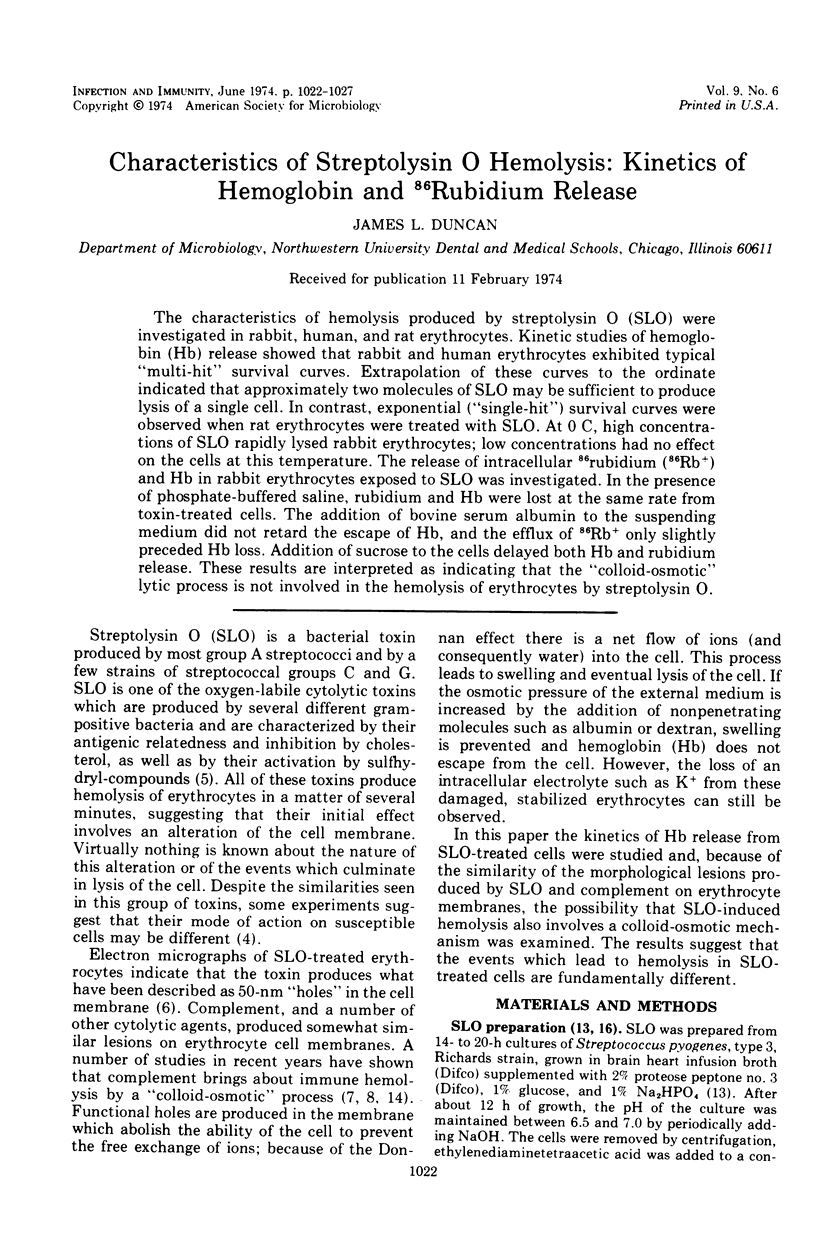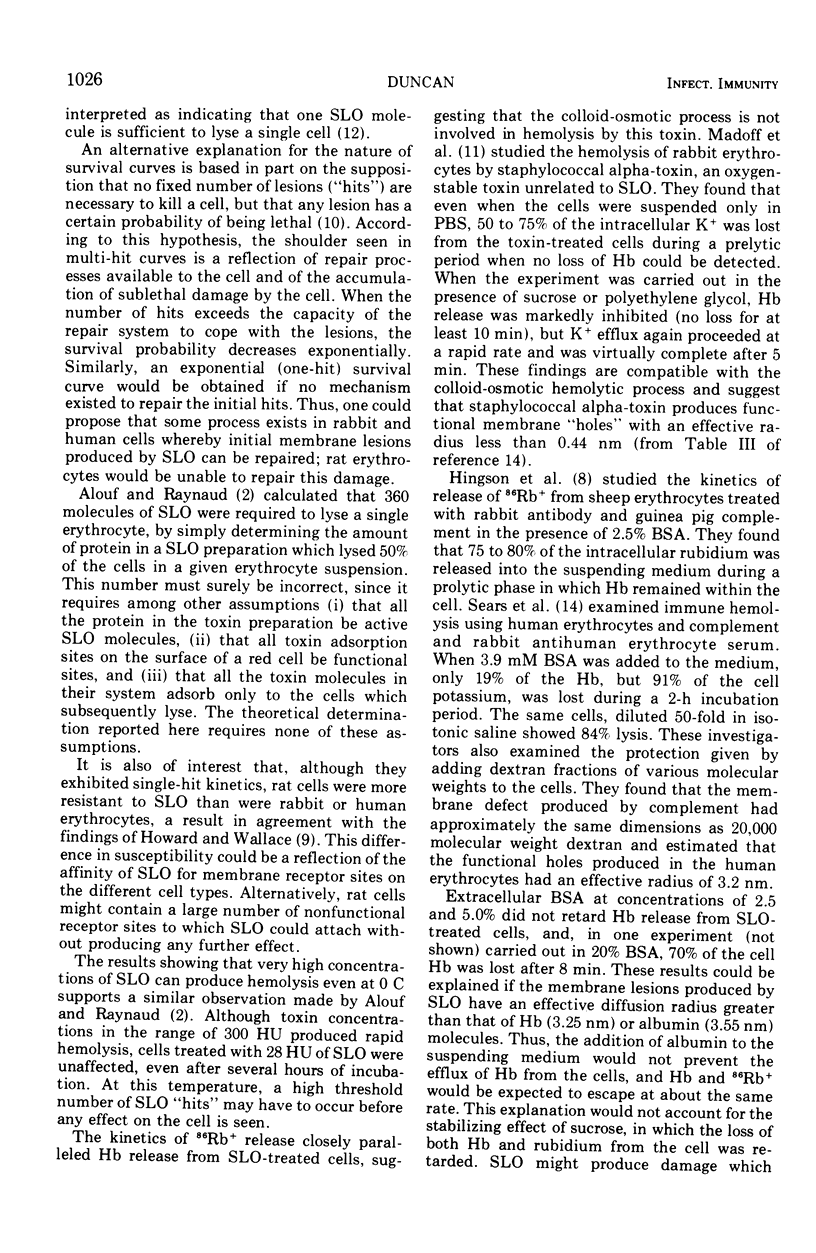Abstract
The characteristics of hemolysis produced by streptolysin O (SLO) were investigated in rabbit, human, and rat erythrocytes. Kinetic studies of hemoglobin (Hb) release showed that rabbit and human erythrocytes exhibited typical “multi-hit” survival curves. Extrapolation of these curves to the ordinate indicated that approximately two molecules of SLO may be sufficient to produce lysis of a single cell. In contrast, exponential (“single-hit”) survival curves were observed when rat erythrocytes were treated with SLO. At 0 C, high concentrations of SLO rapidly lysed rabbit erythrocytes; low concentrations had no effect on the cells at this temperature. The release of intracellular 86rubidium (86Rb+) and Hb in rabbit erythrocytes exposed to SLO was investigated. In the presence of phosphate-buffered saline, rubidium and Hb were lost at the same rate from toxin-treated cells. The addition of bovine serum albumin to the suspending medium did not retard the escape of Hb, and the efflux of 86Rb+ only slightly preceded Hb loss. Addition of sucrose to the cells delayed both Hb and rubidium release. These results are interpreted as indicating that the “colloid-osmotic” lytic process is not involved in the hemolysis of erythrocytes by streptolysin O.
Full text
PDF





Selected References
These references are in PubMed. This may not be the complete list of references from this article.
- Alouf J. E., Raynaud M. Action de la streptolysine O sur les membranes cellulaires . II.--Cinétique de la lyse érythrocytaire. Ann Inst Pasteur (Paris) 1968 Jul;115(1):97–121. [PubMed] [Google Scholar]
- Atwood K. C., Norman A. On the Interpretation of Multi-Hit Survival Curves. Proc Natl Acad Sci U S A. 1949 Dec;35(12):696–709. doi: 10.1073/pnas.35.12.696. [DOI] [PMC free article] [PubMed] [Google Scholar]
- Dourmashkin R. R., Rosse W. F. Morphologic changes in the membranes of red blood cells undergoing hemolysis. Am J Med. 1966 Nov;41(5):699–710. doi: 10.1016/0002-9343(66)90031-3. [DOI] [PubMed] [Google Scholar]
- GREEN H., BARROW P., GOLDBERG B. Effect of antibody and complement on permeability control in ascites tumor cells and erythrocytes. J Exp Med. 1959 Nov 1;110:699–713. doi: 10.1084/jem.110.5.699. [DOI] [PMC free article] [PubMed] [Google Scholar]
- HOWARD J. G., WALLACE K. R. The comparative resistances of the red cells of various species to haemolysis by streptolysin O and by saponin. Br J Exp Pathol. 1953 Apr;34(2):181–184. [PMC free article] [PubMed] [Google Scholar]
- Hingson D. J., Massengill R. K., Mayer M. M. The kinetics of release of 86rubidium and hemoglobin from erythrocytes damaged by antibody and complement. Immunochemistry. 1969 Mar;6(2):295–307. doi: 10.1016/0019-2791(69)90166-9. [DOI] [PubMed] [Google Scholar]
- Kiefer J. Target theory and survival curves. J Theor Biol. 1971 Feb;30(2):307–317. doi: 10.1016/0022-5193(71)90057-9. [DOI] [PubMed] [Google Scholar]
- MADOFF M. A., COOPER L. Z., WEINSTEIN L. HEMOLYSIS OF RABBIT ERYTHROCYTES BY PURIFIED STAPHYLOCOCCAL ALPHA-TOXIN. III. POTASSIUM RELEASE. J Bacteriol. 1964 Jan;87:145–149. doi: 10.1128/jb.87.1.145-149.1964. [DOI] [PMC free article] [PubMed] [Google Scholar]
- Oberley T. D., Duncan J. L. Characteristics of streptolysin O action. Infect Immun. 1971 Dec;4(6):683–687. doi: 10.1128/iai.4.6.683-687.1971. [DOI] [PMC free article] [PubMed] [Google Scholar]
- SEARS D. A., WEED R. I., SWISHER S. N. DIFFERENCES IN THE MECHANISM OF IN VITRO IMMUNE HEMOLYSIS RELATED TO ANTIBODY SPECIFICITY. J Clin Invest. 1964 May;43:975–985. doi: 10.1172/JCI104983. [DOI] [PMC free article] [PubMed] [Google Scholar]
- SOLOMON A. K. The permeability of the human erythrocyte to sodium and potassium. J Gen Physiol. 1952 May;36(1):57–110. doi: 10.1085/jgp.36.1.57. [DOI] [PMC free article] [PubMed] [Google Scholar]
- Whittam R., Ager M. E. Vectorial aspects of adenosine-triphosphatase activity in erythrocyte membranes. Biochem J. 1964 Nov;93(2):337–348. doi: 10.1042/bj0930337. [DOI] [PMC free article] [PubMed] [Google Scholar]


